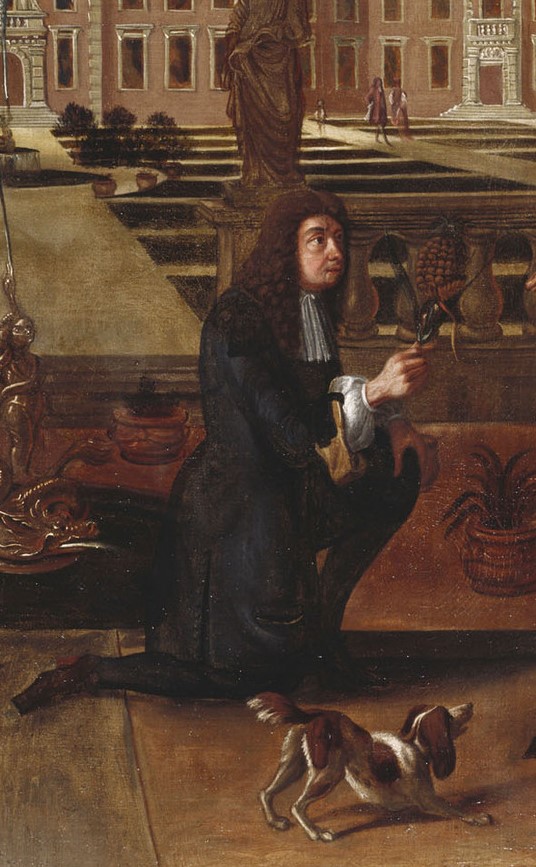Apollo and Daphne in 5 Artworks
From Ancient Rome to the Renaissance and Rococo, the timeless appeal of the Apollo and Daphne myth spans centuries of artistic expression. The myth...
Anna Ingram 30 January 2025
Known as the “pineapple picture,” this enigmatic 17th-century painting captures the royal reception of King Charles II. The British royal is being presented with an exotic fruit – a pineapple! Read on to learn why.
The painting, titled Charles II Presented with a Pineapple, has the Royal Gardener John Rose offering a pineapple to King Charles II of England in an imperial garden setting. Flanking the king are two spaniels, which perhaps are emblems of loyalty and companionship. The mansion part and parcel of that regal splendor is possibly Dorney Court in Dorney, England. With a richly symbolic composition and a meticulously manicured landscape comes an atmosphere of opulence and prestige.

British School, Charles II Presented with a Pineapple, ca. 1675-80, Royal Collection Trust, UK. Detail.
Commonly known as the “pineapple picture,” the four existing versions of this enigmatic artwork have been subject to much conjecture. There is a picture of comparable quality at Houghton Hall, Norfolk, UK attributed to Henry Dankerts. A slightly later copy, housed in the Royal Collection, is created by an unknown artist. Another copy was painted in 1787 by Thomas Stewart for Ham House in Richmond, England.

Godfrey Kneller, Portrait of Charles II of England, ca. 1685, New Orleans Museum of Art, New Orleans, LA, USA.
In all the versions, the focal point of the painting is the mercurial and beguiling Charles II. He is found standing on a terrace with his left hand placed on his hip. His position of power is noted in the opulence of the setting, the reverence placed on him by the subject before him, and even the two dogs surrounding him.
Charles II is portrayed in a rather casual knee-length brown coat, which is significant as it was a style he initiated in October 1666. Displayed on his chest is the prestigious Star of the Garter. This is a rare glimpse of Charles II in ordinary garb rather than the usual ceremonial robes in which he was generally depicted. His ensemble includes a lace rabat, a black hat, and square-toed heeled shoes. Notably, he is without a mustache, a change made in 1677. This portrait has been hailed as a particularly vivid likeness of the king in his later years.

Detail of John Rose from British School, Charles II Presented with a Pineapple, ca. 1675-80, Royal Collection Trust, UK.
Kneeling before Charles II is believed to be his royal gardener, John Rose, presenting what is said to have been the first pineapple grown in England. John Rose passed away in 1677, and it is believed that this painting may have been intended to commemorate the death of the royal gardener.

Maria Sibylla Merian, Plate 1 from Dissertation in Insect Generations and Metamorphosis in Surinam, ca. 1719. National Museum of Women in the Arts, Washington, DC, USA.
While it may be difficult to appreciate the reverence placed on pineapples in this composition, pineapples were a significant rarity and highly valued as an exotic item during the 17th century in England. Now available (and rotting in grocery stores) worldwide, this exotic fruit was formerly a motif symbolizing wealth, exoticism, and hospitality in European art and society.
Pineapples were cultivated and consumed by ancient Mesoamerican civilizations like the Maya and Aztecs. They first made their European debut after the famous explorer Christopher Columbus encountered them in Guadeloupe in 1493 and brought them back to Spain. Given their exotic status, the rare fruit would cost up to $8,000.00 in today’s currency and were also rented out for parties to serve as a centerpiece.
Given the estimated date of the painting, it is more likely that the pineapple being presented by Rose was imported rather than grown in England. Between 1661 and 1668, pineapples from the West Indies were given to the king in 1661 and 1668, and none were technically grown in Britain until the following century.

British School, Charles II Presented with a Pineapple, ca. 1675-80, Royal Collection Trust, UK.
Despite the possible inaccuracies in later interpretations, The Pineapple Picture has certainly served as a conversation piece through the ages. It was widely (though possibly inaccurately) utilized to demonstrate the great advancement of British horticulture and a reflection of power, prestige, and cultural exchange in Baroque art and society.
Although the artist remains elusive, the painting has a powerful impact on viewers, transporting them into a bygone era of royalty, wealth, and cultural exchange, and of course, raising the exciting prospect where the seemingly irrelevant pineapple held profound symbolic significance.
DailyArt Magazine needs your support. Every contribution, however big or small, is very valuable for our future. Thanks to it, we will be able to sustain and grow the Magazine. Thank you for your help!